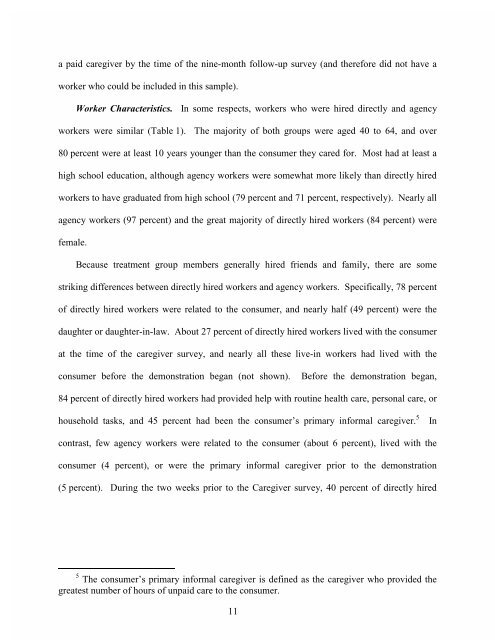The Experiences of Workers Hired Under Consumer Direction in ...
The Experiences of Workers Hired Under Consumer Direction in ...
The Experiences of Workers Hired Under Consumer Direction in ...
You also want an ePaper? Increase the reach of your titles
YUMPU automatically turns print PDFs into web optimized ePapers that Google loves.
a paid caregiver by the time <strong>of</strong> the n<strong>in</strong>e-month follow-up survey (and therefore did not have aworker who could be <strong>in</strong>cluded <strong>in</strong> this sample).Worker Characteristics. In some respects, workers who were hired directly and agencyworkers were similar (Table 1). <strong>The</strong> majority <strong>of</strong> both groups were aged 40 to 64, and over80 percent were at least 10 years younger than the consumer they cared for. Most had at least ahigh school education, although agency workers were somewhat more likely than directly hiredworkers to have graduated from high school (79 percent and 71 percent, respectively). Nearly allagency workers (97 percent) and the great majority <strong>of</strong> directly hired workers (84 percent) werefemale.Because treatment group members generally hired friends and family, there are somestrik<strong>in</strong>g differences between directly hired workers and agency workers. Specifically, 78 percent<strong>of</strong> directly hired workers were related to the consumer, and nearly half (49 percent) were thedaughter or daughter-<strong>in</strong>-law. About 27 percent <strong>of</strong> directly hired workers lived with the consumerat the time <strong>of</strong> the caregiver survey, and nearly all these live-<strong>in</strong> workers had lived with theconsumer before the demonstration began (not shown). Before the demonstration began,84 percent <strong>of</strong> directly hired workers had provided help with rout<strong>in</strong>e health care, personal care, orhousehold tasks, and 45 percent had been the consumer’s primary <strong>in</strong>formal caregiver. 5Incontrast, few agency workers were related to the consumer (about 6 percent), lived with theconsumer (4 percent), or were the primary <strong>in</strong>formal caregiver prior to the demonstration(5 percent). Dur<strong>in</strong>g the two weeks prior to the Caregiver survey, 40 percent <strong>of</strong> directly hired5 <strong>The</strong> consumer’s primary <strong>in</strong>formal caregiver is def<strong>in</strong>ed as the caregiver who provided thegreatest number <strong>of</strong> hours <strong>of</strong> unpaid care to the consumer.11
















